Focus on Inclusive Leadership and Instruction: Ohio's Largest School District Makes Meaningful Improvements in Teaching and Learning for All Students

"We're moving away from a focus on compliance alone and actually doing the work of improving schools," said Kathryn Moser, Executive Director of School Leadership Development (Division III) for the Columbus City Schools (CCS). CCS is Ohio's largest district, serving more than 49,000 children in 109 schools across the city.
Moser (pictured to the left) oversees one of three elementary divisions within the district with each division serving about 25 elementary schools. A middle school division and a high school division work with secondary schools. When the divisions were created two and a half years ago, the decision was made to assign all elementary schools in priority status to Moser.1
According to Moser, nine of the 15 elementary schools moved out of priority status this year. She attributed this accomplishment to the district's engagement over the past two years with the Ohio Leadership for Inclusion, Implementation, and Instructional Improvement (OLi4) program2. As important for Moser is the fact that "of the focus3 schools that participated in OLi4 and received tiered support, none moved into priority school status. And it did not take years to make meaningful improvements," reported Moser.
Operationalizing Inclusive Leadership
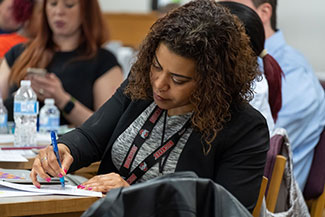
"Because of the strong change we saw last year, we were able to add an additional elementary division this year to participate in OLi4," said Moser. Moser's division participated as "Cohort 1" beginning in 2017-18. The second cohort is currently participating in its first year of OLi4. Cohort 1 has shown steady gains in the use of inclusive leadership practices, such as coaching teaching and using research and evidence to guide instruction. "Principals have improved their understanding of what effective instruction looks like, through shared leadership and focus on improved instruction and simultaneously developing effective BLT and TBT processes, and have more systemically affected change across their schools," observed Moser.
Components of OLi4 Professional Learning
Principals and teacher leaders from each building in the divisions participate in the following four inter-related professional learning components:
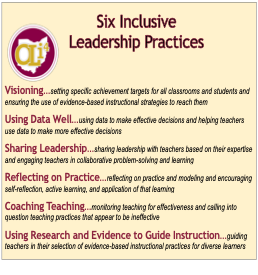
Centralized Professional Learning
Six sessions (three per year) with nationally recognized experts in district and school improvement, systems change, curriculum and instruction, and data-based decision making;
Regional Cadre Discussion Groups
Twelve half-day sessions (six per year) providing principals and teacher leaders with an opportunity to focus on the application of particular practices in their school settings;
Principal Coaching Sessions:
Weekly individualized coaching sessions give the principal and coach the opportunity to discuss progress in areas of work and emerging competence in using inclusive instructional leadership practices; and
Online Readings and In-school Activities:
Ongoing guided readings, practical assignments, use of Ohio Leadership Advisory Council (OLAC) online learning resources4, and reflection prompts support principals in extending knowledge gained through other professional learning components.
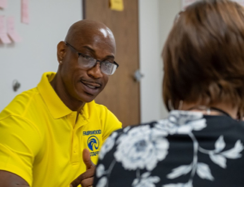
These experiences enable principals and teacher leaders to learn to use six inclusive instructional leadership practices in two key parts of their work: leading learning teams (i.e., building leadership teams, teacher-based teams) and coaching instruction.
CCS was intentional in involving teacher leaders along with principals from each participating school. "This has been tremendous for teacher leaders as well as for principals. We were explicit about the fact that it's not one more thing; it's about replacement behaviors. By learning together about research-based leadership strategies, we've gotten better," said Moser.
A Powerful Learning Experience.
According to Moser, OLi4 guides leaders to begin improvement efforts by looking at what works in their schools. Taking an assets viewpoint is a stronger starting place than assuming a deficit viewpoint. For example, one of the initial assignments asks principals to study the work of their most effective teachers to gain greater understanding of what constitutes high-quality instructional practice. Moser aligned principals' work through OLi4 with expectations related to teacher evaluation, instructing principals to begin Ohio Teacher Evaluation System (OTES) evaluations with their most accomplished teachers.
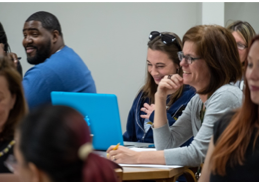
Unlike the statewide OLi4 project, which involves cohorts of 60 or more principals from all parts of Ohio traveling to Columbus for a portion of the two-year PD program, CCS principals meet at convenient locations within the district and in Columbus. "Pam VanHorn has been incredibly responsive in customizing OLi4 PD for CCS," said Moser. "The PD is offered right here in Columbus and principals don't have to travel and are still able to meet the needs of their buildings; it continues to be an incredibly powerful learning opportunity for us," she added.
School leaders' participation in OLi4, combined with Moser's continuous and focused support, is making the difference. Growth in knowledge and skill in using inclusive instructional leadership practices has steadily increased, and building leadership teams (BLTs) and teacher-based teams (TBT) are increasingly taking responsibility for schoolwide implementation of selected instructional strategies.
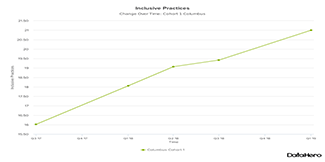
"It's easy to spend so much time and energy on collecting student data and deflect responsibility for adult implementation. OLi4 does not allow our leaders to do that and instead provides a helpful structure to really focus on what the adults do to improve student learning," explained Moser.
Moser contrasts OLi4 with other PD programs noting that, "OLi4 PD provides direct support to principals about what they need to do to improve teaching and learning as compared to what others should do, which is the focus of the majority of PD in which principals participate. And, OLi4 sessions aren't always easy; in fact, they often cause some discontent."
Despite what OLi4 asks of them, school leaders in Moser's division see its benefits. According to Moser, "when principals began to realize that the district was investing in their development and what they needed to do in order to be a stronger leader, they got refueled!"
Priority and focus schools are required to submit evidence of use of the Ohio Improvement Process (OIP) through the state's Comprehensive Continuous Improvement Plan (CCIP). OLi4 makes connections to the Ohio 5-step process in supporting principals to more effectively use the process to focus on instructional improvement. Moser explains:
It was easy for principals to upload evidence because of their work through OLi4, making monitoring easy to accomplish. But monitoring isn't the end goal; it's an artifact of doing the right work. We've moved from a focus on compliance to a focus on leadership and instructional improvement and, by doing so, we can easily meet the compliance requirements.
During the 2018-19 project year, CCS was able to expand to include a second division of schools with support from SST Region 11 coaches who aligned their services and visits to CCS schools to reinforce the learning that was occurring in monthly OLi4 sessions. "OLi4 provided the structure for focused support in those schools," said Moser.
Transforming Central Office Roles & Functions
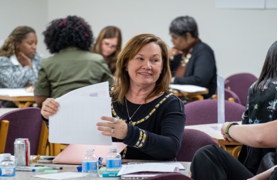
Moser participates in OLi4 alongside her principals and teacher leaders, sending the strong message that the work is important, aligned with district priorities, and responsive to district needs. At the same time, she's been able to use her Division's involvement in OLi4 and what she's learning from participating principals and teacher leaders to support system-wide improvements. Working in a supportive role alongside principals is critical to transforming central office functions in ways that improve adult and student learning (Honig & associates, 2010).
"We're in a much stronger place than we were several years ago as a district. When I identified OLi4 as the best approach for moving forward, I was able to align the work that principals were doing through OLi4 with other critical functions," explained Moser. "We shifted the focus of district leadership team meetings from just reviewing data to actually responding to the needs of building leadership teams, and we're now truly monitoring our district improvement plan, which is now much more focused and strategic," she added.
Overcoming Challenges, Gaining Focus
Moser has also taken steps to change the way monthly division meetings with principals are used. Rather than providing updates on a variety of initiatives, meetings now serve as monthly OLi4 cadre sessions, focusing on the application of the inclusive instructional leadership practices the principals are learning through OLi4 PD.

"Time is the biggest issue. Principals would often walk out of monthly meetings feeling overwhelmed and not clear on which initiatives they should address first. We revamped the meetings to protect that time for adult learning. It took discipline at the beginning and a lot of saying ‘no' but the principals appreciate it and it allows them to be much more focused," explained Moser.
Moser has visited every building leadership team (BLT) in her Division and has observed principals' development of particular practices, such as sharing leadership, using these observations as her second-cycle observations of principals in every school.
"Just as I was expecting principals to align teacher evaluations to what they were learning through OLi4, I was also aligning my evaluations of principals with the same work," she said. OLi4 has made my work as a supervisor easier. I don't ask principals to create artifacts for evaluation purposes. OLi4 hits all aspects of principal evaluation, so by doing the work, they're providing evidence in relation to every aspect of the OPES rubric," added Moser.
It's About Equity

CCS sets achievement and growth goals to which all school improvement plans align. Making a year's worth of growth for students who are working below grade level isn't sufficient. "In CCS, we're focused on the achievement of all students. The OLi4 framework is intended to support leadership of inclusion and equity for all students. It's exciting to see principals so ready to do this work with true focus and intention about equity and teacher leaders who are passionate about meeting the needs of all students," exclaimed Moser.
"We need to put everything in the context of equity and make sure our work is aligned with this commitment. We do make a difference and with a very strategic plan we'll not only accelerate growth but hit achievement goals," said Moser. "There is still much work to be done, but we're on track and once you learn new behaviors, you don't unlearn them," she added. According to Moser, "OLi4 is customizable to meet district need, irrespective of the district improvement structure."
So what are the next steps for CCS?
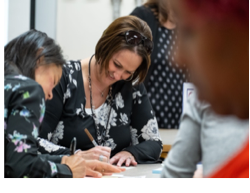
Columbus is exploring the possibility of involving middle and high schools in OLi4 for the 2019-2020 school year. At the same time, CCS would like to involve the third elementary school Division in the work.
As Moser says, "in other words, everyone!"
1. In Ohio, priority schools, also known federally as Comprehensive Support and Improvement Schools (CSI) include, at a minimum, the lowest-performing five percent of schools.
2. OLi4 is a professional development program created and implemented by the University of Cincinnati Systems Development & Improvement Center with support from the Ohio Department of Education.
3. In Ohio, focus schools, also known federally as Targeted Support and Improvement Schools (TSI), include schools that struggle with large achievement gaps in student performance and graduation rate.
4. For more information about OLAC online learning resources, go to www.ohioleadership.org.
5. The OIP was developed to work in concert with Ohio’s Leadership Development Framework (BASA, 2013) in supporting districts to enact or operationalize essential practices at the district, school, and classroom level.
References
Honig, M. I., Copland, M. A., Rainey, L., Lorton, J. A., & Newton, M. (April 2010). Central office transformation for district-wide teaching and learning improvement. University of Washington, Center for the Study of Teaching & Policy.
Ohio's leadership development framework (2nd ed.). (2013). Columbus, OH: Buckeye Association of School Administrators (BASA).